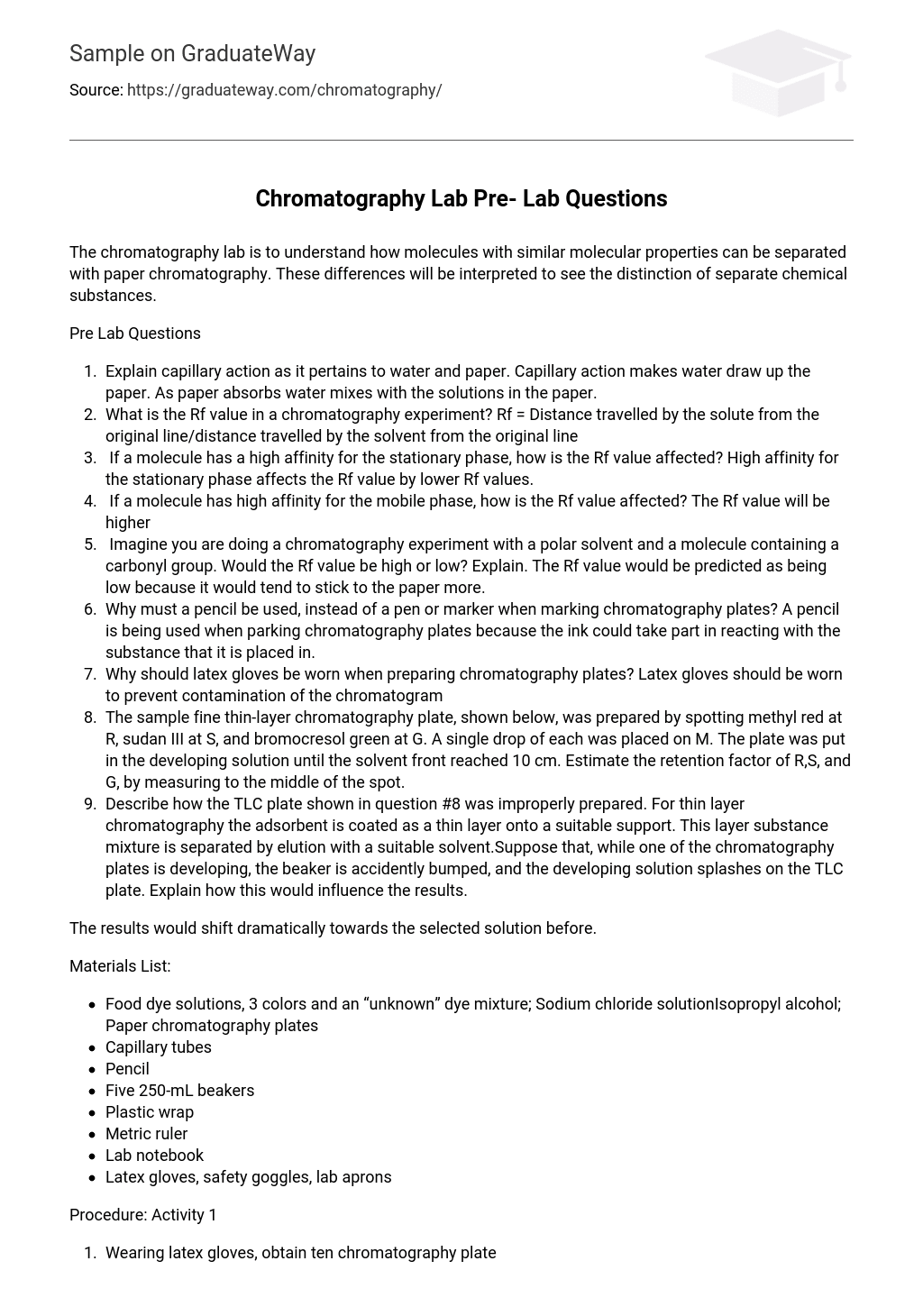The chromatography lab is to understand how molecules with similar molecular properties can be separated with paper chromatography. These differences will be interpreted to see the distinction of separate chemical substances.
Pre Lab Questions
- Explain capillary action as it pertains to water and paper. Capillary action makes water draw up the paper. As paper absorbs water mixes with the solutions in the paper.
- What is the Rf value in a chromatography experiment? Rf = Distance travelled by the solute from the original line/distance travelled by the solvent from the original line
- If a molecule has a high affinity for the stationary phase, how is the Rf value affected? High affinity for the stationary phase affects the Rf value by lower Rf values.
- If a molecule has high affinity for the mobile phase, how is the Rf value affected? The Rf value will be higher
- Imagine you are doing a chromatography experiment with a polar solvent and a molecule containing a carbonyl group. Would the Rf value be high or low? Explain. The Rf value would be predicted as being low because it would tend to stick to the paper more.
- Why must a pencil be used, instead of a pen or marker when marking chromatography plates? A pencil is being used when parking chromatography plates because the ink could take part in reacting with the substance that it is placed in.
- Why should latex gloves be worn when preparing chromatography plates? Latex gloves should be worn to prevent contamination of the chromatogram
- The sample fine thin-layer chromatography plate, shown below, was prepared by spotting methyl red at R, sudan III at S, and bromocresol green at G. A single drop of each was placed on M. The plate was put in the developing solution until the solvent front reached 10 cm. Estimate the retention factor of R,S, and G, by measuring to the middle of the spot.
- Describe how the TLC plate shown in question #8 was improperly prepared. For thin layer chromatography the adsorbent is coated as a thin layer onto a suitable support. This layer substance mixture is separated by elution with a suitable solvent.Suppose that, while one of the chromatography plates is developing, the beaker is accidently bumped, and the developing solution splashes on the TLC plate. Explain how this would influence the results.
The results would shift dramatically towards the selected solution before.
Materials List:
- Food dye solutions, 3 colors and an “unknown” dye mixture; Sodium chloride solutionIsopropyl alcohol; Paper chromatography plates
- Capillary tubes
- Pencil
- Five 250-mL beakers
- Plastic wrap
- Metric ruler
- Lab notebook
- Latex gloves, safety goggles, lab aprons
Procedure: Activity 1
- Wearing latex gloves, obtain ten chromatography plates, as directed by the instructor. Prepare each chromatography plate by marking lightly with pencil, a line at the bottom. Draw two small dots on the bottom line. Place the labels B (blue) and R (red) below the dots on the line. Repeat with the yellow food dye (Y) on another chromatography paper. Prepare the remaining eight plates the same way so that you have five sets of chromatography plates.
- Properly prepare 250 mL beakers
- Cover 250 mL beakers with plastic wrap
- Prepare 10 mL of below solution and place them in the beakers. Label with the mobile phase composition. a. 1% salt water
1% salt water/isopropyl alcohol (3:1) mixture
1% salt water/isopropyl alcohol (1:1) mixture
1% salt water/isopropyl alcohol (1:3) mixture
isopropyl alcohol - cover each beaker with a piece of plastic wrap
- Prepare 1 mL of each dye solution
- Place one drop of blue food dye with the capillary tube
- Do this for the “R” (separate capillary tube)
- Do this for the “Y” (separate capillary tube)
- Allow droplet to fully dry
- Gently lower one of the plates into one of the 250-mL developing solution beakers, ensuring that the dry food dye spots are at the bottom. Ensure that no solvent splashes onto the chromatography plate above the initial solvent level
- Carefully re-cover the 250-mL beaker
- The solvent will quickly rise through the plate. Allow until ¾ way
- Once the solvent level has reached the maximum height, quickly remove the plate from the 250-mL beaker and mark the exact point of the solvent front before the solvent evaporates. (will take longer)
- Mark the plate with the identity of the developing solution composition. Set the plate face-up to allow it to dry
- Replace the plastic wrap cover on the 250-mL beaker
- Repeat steps 7-16 with each of the other developing solutions. Ensure that each plate is properly marked and labeled
- Measure the distance between the bottom line and the upper solvent line on each plate. Record this information in the data table 1 for the corresponding developing solution
- Identify and circle each spot corresponding to the indicator dyes on each of the chromatography plates
- Measure the distance between the bottom line and the center of each indicator spot (B,R andY) on each plate. Record this data in the corresponding data table 21. Ask the instructor whether the chromatography plates should be retained or disposed off.





